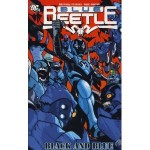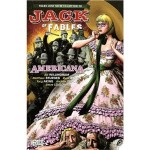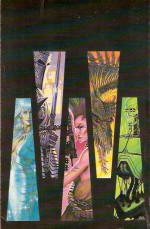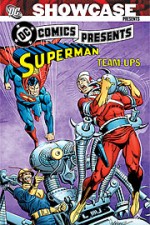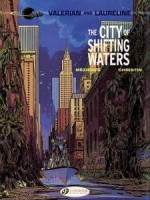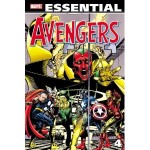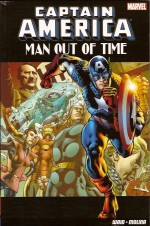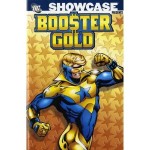
By Dan Jurgens & various (DC Comics)
ISBN: 978-1-84576-852-2
After the cosmos-crunching Crisis on Infinite Earths re-sculpted the DC Universe in the mid-1980s, a host of characters got floor-up rebuilds for the tougher, no-nonsense, straight-shooting New American readership of the Reagan-era and a number of corporate buy-outs such as Blue Beetle, Captain Atom and The Question joined the DC roster with their own much-hyped solo titles. There were even a couple of all-new big launches for the altered sensibilities of the Decade of Excess such as Suicide Squad and a Shiny, Happy Hero named Booster Gold.
This economical black and white edition (released to coincide with the hero’s relaunch as a time-roving chronal cop) features the entire 25 issue run of Booster Gold volume 1 (from February 1986 to February 1988), plus a crossover appearance from Action Comics #594 and his redefined backstory from Secret Origins #35 (December 1988).
The blue and yellow paladin appeared amidst plenty of hoopla in his own title cover-dated February 1986 (the first post-Crisis premiere of the freshly integrated superhero line) and presented a wholly different approach to the traditional DC costumed boy-scout. Created, written and drawn by Dan Jurgens with inks by Mike DeCarlo ‘The Big Fall’ introduced a brash, cocky, mysterious metahuman golden-boy jock who had set up his stall as a superhero in Metropolis, actively seeking corporate sponsorships, selling endorsements and with a management team in place to maximise the profit potential of his crusading celebrity.
Accompanied everywhere by a sentient flying-football-shaped robot Skeets, the glitzy showboat soon encountered high-tech criminal gang The 1000 and their super-enforcer Blackguard, earning the ire of sinister mastermind The Director and the shallow approbation of models, actresses, headline-hungry journalists, politicians and the ever fickle public…
In issue #2’s ‘Cold Redemption’ Blackguard was assisted by thought-casting mercenary Mindancer as the Director’s campaign of malice led to another close call for Booster. Meanwhile his highly public private life took a tawdry turn in ‘The Night Has a Thousand Eyes’ when opportunistic starlet Monica Lake began briefing the media on her “relationship†with the Man of Gold. He was unable to refute the claims since he was knee-deep in hired thugs and super-villains at the time…
That cataclysmic combat in #4 resulted in a tremendous ‘Crash’ when urban vigilante The Thorn dropped in to help scuttle the 1000’s latest scheme, but once the dust settled Booster found himself in real trouble as business manager Dirk Davis was so busy licensing his boss for a comicbook that he failed to head off an IRS audit…
It appeared Booster Gold had no official record and had never paid a penny in taxes…
In ‘Face Off’, our hero saved an entire stadium of ice hockey fans from avaricious terrorist Mr. Twister, earning himself a reprieve from the Federal authorities, after which an alien refugee crashed in Metropolis’ Centennial Park in #6’s ‘To Cross the Rubicon’, just as Man of Gold met Man of Steel for the long-awaited origin saga.
Michael Jon “Booster†Carter was a rising sports star in the 25th century who fell in with a gambling syndicate and began fixing games for cash pay-outs. When he was caught and banned from competition he could only find menial work as a night-watchman in The Space Museum. Whilst there he struck up a friendship with automated tour-guide and security-bot Skeets, embarking on a bold plan to redeem himself.
Stealing a mysterious flight ring and force-field belt plus energy-rods, an alien super-suit and wrist-blasters, Booster used the Museum’s prize exhibit, Rip Hunter’s time machine, to travel to 20th Century Age of Heroes and earn all the fame and glory his mistakes had cost him in his own time…
Superman, already antagonistic because of Booster’s attitude, is ready to arrest him for theft when the almost forgotten alien attacks…
They all awaken on a distant world embroiled in a vicious civil war and still at odds. As a result of ‘The Lesson’ and a vicious battle Superman and Booster Gold both learned some uncomfortable truths and agreed to tolerate each other when they returned home. Meanwhile, back in Metropolis, Dirk Davis and company PA Trixie Collins hired hotshot scientist Jack Soo to build a super-suit that would enable Booster to hire a camera-friendly, eye-candy, girly sidekick…
More questions were answered in the two-part ‘Time Bridge’ when the 30th century Legion of Super-Heroes discovered evidence that their flight-rings and forcefield technology were being used by a temporal fugitive named Michael Carter. Dispatched to 1985 by the Time Institute, Ultra Boy, Chameleon Boy and Brainiac 5 arrived soon after the fugitive Carter and became involved in his very first case. The Director and shape-shifting assassin Chiller were planning to murder and replace Ronald Reagan but in the best superhero tradition Carter and the Legionnaires misunderstood each other’s intentions and butted heads…The plot might have succeeded had not Skeets intervened, allowing Carter to save the day and get official Presidential approval. Ronnie even got to name the new hero…
Back in 1986 the long-building final clash with the Director began in #10 with ‘Death Grip of the 1000’ when Dirk’s daughter was kidnapped and he was coerced into betraying Booster, just as the nefarious super-mob unleashed a horde of robotic terrors on Metropolis to wear out the Man of Gold and assess his weaknesses…
After Trixie was also abducted in ‘When Glass Houses Shatter’ the 1000 increased the pressure by setting blockbusting thug Shockwave on Booster, resulting in the utter destruction of the hero’s corporate headquarters and home before a frenzied and frenetic final clash in ‘War’…
With the threat of the 1000 ended ‘The Tomorrow Run’ (inked by Gary Martin) found Booster at death’s door, not because of his numerous injuries but because his 25th century body had succumbed to 20th century diseases. Set during the Legends publishing event, which saw the public turn violently against costumed heroes, the dying Carter was rescued from a mob by Trixie wearing Jack Soo’s completed super-suit after which the cast resolve to take Michael back to the future where he can be properly treated, even though Booster’s offences carried a mandatory death penalty in his home era…
Recruiting young Rip Hunter (destined to become the Master of Time) Trixie and Dr. Soo accompanied the distressed hero to a time where ruthless Darwinian capitalism ruled and everything Michael Carter once dreamed of had turned to bitter ashes…
‘A Future Lost’ (inked by DeCarlo) followed Booster and Trixie as they searched for a cure (and his missing twin sister Michelle) whilst Hunter and Soo attempted to find a way to return them all to 1986.
Booster’s illness was only cured after they were arrested: the authorities believing it barbaric to execute anybody too sick to stand up, before ‘Runback’ (inked by Bruce D. Patterson) concluded the saga in fine style with the missing Carter twin saving the day and retreating to the 20th century with the time-lost travellers.
Booster Gold’s close call had a salutary effect on his attitudes and character. ‘Fresh Start’ (inked by Bob Lewis) saw a kinder, gentler corporate entrepreneur begin to re-establish his heroic credentials with the celebrity-crazed public of Metropolis, to the extent that Maxwell Lord even offered him membership in the newly re-formed Justice League, just as sultry assassin Cheshire began raiding a biotech company recently acquired by Booster Gold International…
‘Dream of Terror’ (inked by Arne Starr) revealed all as new owner Booster discovered that his latest corporate asset had been making bio-toxins designed to eradicate all “undeserving†individuals (for which read non-white and poor) and that its creator was currently loose in Mexico City with the lethal bug. Moreover, the deranged biochemist had bamboozled militant hero the Hawk into acting as bodyguard while his plans to “save humanity from itself†took effect…
Decarlo returned to ink ‘Showdown’ in #18, as a relentless lawman from Booster’s home-time tracked him down through history, determined to render final judgement before ‘Revenge of the Rainbow Raider’ (inked by Al Vey) pitted the Man of Gold against the colour-blind and utterly demented Flash villain in a two-part revenge thriller that saw our hero rendered sightless and his future shocked sister go native amongst the 20th century primitives.
The tale concluded with ‘The Colors of Justice’ as Dr. Soo came to Booster’s rescue whilst Michelle was being kidnapped by extra-dimensional invaders…
Up until this moment the art in this volume, whilst always competent, had been suffering an annoying hindrance, designed as it was for high quality, full-colour comicbooks, not stark, black and white reproduction. Although legible, discernable and adequate, much of the earlier art is fine-lined, lacking contrasting dark areas and often giving the impression that the illustrations lack solidity and definition.
With Booster Gold #21 the marvellous Ty Templeton became regular inker and his bold, luscious brush-strokes brought a reassuring firmness and texture to the proceedings. As if to affirm the artistic redirection the stories became a tad darker too…
‘Invasion From Dimension X’ has Booster’s search for his missing sister impinge on a covert intrusion by belligerent aliens first encountered and defeated by the Teen Titans (see Showcase Presents Teen Titans volume 2). To make matters worse the extra-dimensionals are using Michelle as a power-source to fuel their invasion, resulting in ‘Tortured Options’ for Booster who had to decide between saving Michelle or the city of Minneapolis when the invaders opened their assault with a colossal monster attack…
Guest-starring Justice League International, the astounding battle climaxed in public triumph and personal tragedy after which the heart-broken, embittered Booster seemingly attacked Superman in ‘All That Glisters’ (Action Comics #594, November 1987, by John Byrne & Keith Williams); a terse, brutal confrontation that concluded in Booster Gold #23 and ‘Blind Obsession’ (Jurgens & Roy Richardson) as the real Man of Gold crushed a Kryptonite-powered facsimile android designed by the world’s most unscrupulous businessman to kill Superman and frame his closest commercial rival…
If only they had known that at that very moment Booster Gold International was being bankrupted by a traitor at the heart of the company…
After Crisis on Infinite Earths and Legends, DC’s third company-wide crossover Millennium saw Steve Englehart describe how robotic peacekeepers called Manhunters had infiltrated Earth to abort the next stage in human evolution. Built by the Guardians of the Universe billions of years ago, the automated peacekeepers had rebelled against their creators and now planned to thwart their makers’ latest project, destroying or suborning Earth’s costumed defenders in the process.
In its original form each weekly instalment of Millennium acted as a catalyst for events which played out in the rest of the DC Universe’s comics. In addition to the miniseries itself, Millennium spread across 21 titles for two months – another 37 issues – for a grand total of 44 comic-books. Issues #24 and 25 of Booster Gold were two of them.
‘Betrayal’ revealed that one of Michael Carter’s inner circle had been a Manhunter agent all along and had bankrupted the hero at the most propitious moment simply so that the robots could buy his loyalty during their assault on humanity…
The series came to a shocking climax in ‘The End’ as the scheme worked and Booster actually switched sides… or did he?
After the surprisingly satisfying and upbeat denouement Booster became a perennial star of Justice League International where, with fellow homeless hero Blue Beetle, he became half of the one of funniest double-acts in comics. As “Blue and Gold†the hapless, cash-strapped odd couple were always at the heart of the action – pecuniary or otherwise – and the final tale here ‘From the Depths’ (by Jurgens & Tim Dzon, originally presented in Secret Origins #35, December 1988) reprised the early tragic days of Michael Jon Carter in a brief and exceedingly impressive tale played as much to tug the heartstrings as tickle the funny-bone…
As a frontrunner of the new DC, Booster Gold was a radical experiment in character that didn’t always succeed, but which definitely and exponentially improved as the months rolled by. The early episodes are a necessary chore but by the time the volume ends it’s a real shame that the now thoroughly entertaining and enjoyable ride is over. Perhaps not to every Fights ‘n’ Tights fan’s taste; these formative fictions are absolutely vital to your understanding of the later classics. Cheap and fun this book is worth the investment simply because of what follows in such comics gems as Justice League International volume 1 and 2 and Booster Gold: Blue and Gold.
© 1986, 1987, 1988, 2008 DC Comics. All Rights Reserved.
